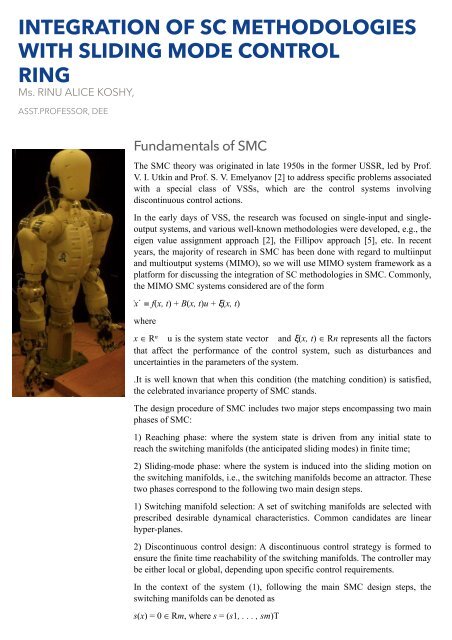combinepdf
Create successful ePaper yourself
Turn your PDF publications into a flip-book with our unique Google optimized e-Paper software.
and there are other variants.<br />
2) Bang-bang-type SMC: This is a control of direct switching type<br />
should be large enough to suppress all bounded uncertainties and unstructured systems dynamics. Design of<br />
such control relies on the Fillipov method, by which, a sufficient large local attraction region is created to<br />
suck in all system trajectories.<br />
3) Enforce<br />
to realize finite time reachability, where R>0 and K>0 are diagonal matrices and<br />
Key Issues in SMC Theory and Applications<br />
There are several key issues that are commonly seen as obstacles affecting the wide spread applications of<br />
SMC, which have prompted the extensive use of SC and other technologies<br />
in SMC systems in recent years. Some of these are listed in the following.<br />
1) Chattering:<br />
As has been previously mentioned, SMC is a special class of VSSs, in which the sliding modes are induced<br />
by disruptive control forces. As demonstrated in the previous sections, despite the advantages of simplicity<br />
and robustness, SMC generally suffers from the well-known problem, namely,chattering , which is a motion<br />
oscillating around the predefined switching manifold(s). Two causes are commonly conceived.<br />
1. The presence of parasitic dynamics in series with the control systems causes a small-amplitude highfrequency<br />
oscillation. These parasitic dynamics represent the fast actuator and sensor dynamics<br />
which are normally neglected during the control design.<br />
2. The switching non idealities can cause high-frequency oscillations. These may include small time<br />
delays due to sampling [e.g., zero-order hold (ZOH)], and/or execution time required for calculation<br />
of control, and more recently, transmission delays in networked control systems.<br />
Various methods have been proposed to “soften” the chattering. Examples are as follow.<br />
1. The boundary layer control in which the sign function is replaced by which could be a constant or a<br />
function of states as well.<br />
2. The continuous approximation method in which the sign function is replaced by a continuous<br />
approximation Where ε is a small positive number This, in fact, gives rise to a high-gain<br />
control when the states are in the close neighborhood of the switching manifold.<br />
2) Matched and Unmatched Uncertainties:<br />
It is known that the celebrated invariance property of SMC lies in its insensitivity to matched<br />
uncertainties when in the sliding mode. However, if the matching condition is not satisfied, the sliding<br />
mode (motion) is dependent on the uncertainties ξ which is not desirable because the condition<br />
for the well-known robustness of SMC does not hold. Research efforts in this aspect have<br />
been focused on restricting the influence of the uncertainties ξ within a desired bound.




